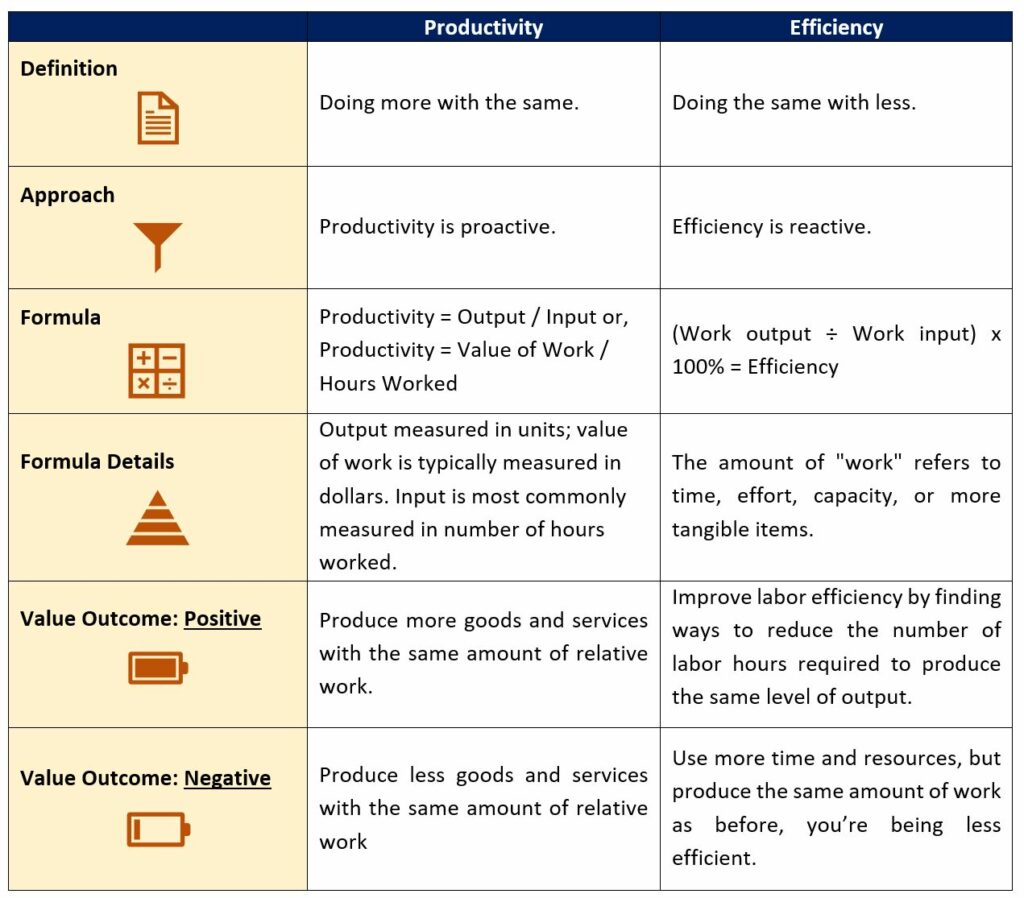Introduction
When a major business crisis occurs, such as the 2008 Recession and the COVID-19, sustaining a positive and motivated workforce is vital to maintaining short and long-term employee engagement and productivity and, ultimately, market success. According to published news, research, and anecdotal evidence, business managers recognize that companies operating in most industry segments face similar undaunting strategic challenges for survival, currently in the ‘new normal’ and the post-pandemic ‘next normal.’
The ‘next normal’ will undoubtedly involve changing traditional working life and revitalizing the conventional corporate cultures and business leadership roles and responsibilities. This forward and uncharted period will be typified by employees shifting seamlessly between the office and offsite work facilities supported by advanced digital transformation initiatives. Empowering strategies and policies will energize and continually boost employee motivation, engagement, productivity, and organizations inherently will adapt quickly to customer demands and competitive challenges.
The ‘new normal’ following the COVID-19 outbreak and the lockdowns resulted in significant changes to the traditional family, social, and workplace activities. Strict and mandatory edicts characterized this period, and rules were temporary and ununiformed in many cases. The ‘next normal’ environment comes after lifting restrictions and getting back to pre-pandemic times, albeit with changes that will reshape the future of working life with a fundamentally new way of managing human resources and leveraging and exploiting digital technology.
“Don’t throw the baby out with the bathwater” is an idiom for an avoidable error in eliminated something good when trying to get rid of something bad, or in other words, rejecting the favorable along with the unfavorable. In the ‘next normal,’ successful companies understand the vital corporate elements to keep and reinforce while avoiding unnecessary changes during this period of uncertainty. Business leaders need to continually strengthen a much-need sense of business stability with links to traditional anchors.
Workplace best practices acknowledge the relationship between a successful corporate action program that proactively aligns and manages the inputs and outputs of employee motivation, engagement, and production activities.
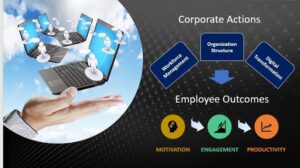
Outlined below are the mission-critical situations that require immediate non-traditional change decisions focusing on strategies and policies that protect and support the most critical corporate asset – employees.
Workforce Management
Management’s walking the talk and displaying genuine empathy and understanding of a crisis and impacts, prioritizing employees’ financial, mental health, and well-being needs can positively influence and improve worker motivation, engagement, and productivity. Concurrently, critical boardroom decisions are necessary on the suitable formula for managing the workforce and wage and benefit costs while responding dynamically to market-driven supply and demand needs while considering the long-term situation.
Employees working within organizations with proactive leadership and defined roles and responsibilities show higher motivation and engagement levels. More connectedness and involvement mean employees are more likely to remain loyal and supportive of their employer and less likely to experience burnout.
By promoting candidates internally as a cornerstone of the corporate culture, employees will become more engaged because Generation Y and Z workers value professional development and advancement opportunities. With employees recognizing they have a chance to move up the ladder, they will be dedicated and involved, leading to a highly motivated and engaged workforce.
There is a possible conflict with harmful outcomes resulting from the strategic decisions for all company stakeholders. The appropriate listening vehicles must be set-up to quickly identify erosion of employee motivation, engagement, and productivity and be in a position to assess risk, change strategic direction, policies, and initiatives found to be unacceptable.
Organization Structure
Pre-COVID-19, many companies experienced a lack of workplace connectivity resulting from unwarranted divisional and functional silos, technology architecture drawbacks, and traditional untouchable sacred cows. The emergence of the ‘new normal’ and evolution to the ‘next normal’ environment require balanced on-site and off-site worker segments, with innovative organizational and team set-up and technology infrastructure enhancements necessary to support a successful collaborative hybrid workplace.
“Re-create a flexible work policy by working with HR to ensure that the policy starts from a position of the location being neutral and working from home as an acceptable option, not the exception. Use this policy to enable managers’ and supervisors’ consistent decision making related to work location, and to avoid the appearance of favoritism or bias.”
Gartner
There will also be a renewed focus on a more effective technology-driven business process model, incorporating increased employee empowerment, teamwork, and knowledge-sharing with ‘on the spot’ decision-making. In many ways, creating a successful business process model is akin to solving Rubik’s Cube with about 43 quintillion possible combinations! The secret to designing a highly-productive business process, always a challenge, is similar to solving the Rubik by creating a formal algorithm with specific steps and enforcing discipline.
Digital Transformation
During the physical business lockdown, there was a significant amount of workplace technology experimentation, leading to various innovative and productive workplace practices implemented. As a result, the ‘new normal’ going forward will likely include many new and changed methods that will alter people’s understandings and behaviors to the work experience, all supported with advanced digital transformation.
It is a known fact that organizations do not change; people do by accepting the need to modify personal behaviors. Required employee behavior changes need to be explicit and practical and include “Moments-of-Truth” relevant to how individual employees handle future internal and external interactions and decision-making. It is also critical to be transparent, during the change program, with all employees, stakeholders, and customers aware of what is at stake, the impacts, and why the business is making a pivot at this point.
In the ‘next normal’ working environment, the successful union of technological innovation with highly engaged and motivated employees empower organizational-level productivity growth. Generally, the most substantial output increases are achievable at a given level of input, from more effective use of the technologies supported by a proactive management team mentoring a willing and able workforce. It is much easier to track employee productivity and outcomes and quickly change routines and approaches with the work linked to specific system-supported goals or OKRs (Objectives and Key Results).
“As we emerge from the lockdown, most companies are looking at how they can restructure and emerge stronger for the next decade. In addition to considering issues such as the ideal business model and operational resilience, companies are focusing on how to sustain some portion of this increased productivity and transformative power into the future.”
World Economic Forum
The Productivity Enabler
Productivity is the efficient use of resources, labor, capital, land, materials, energy, information, and various goods and services. Higher productivity means accomplishing more with the same amount of resources or achieving a higher output in terms of volume and quality from the same input. Productivity measures can be studied collectively (across the whole economy) or viewed industry by industry and individual organizations to analyze labor growth trends, salary levels, and technological enrichment.
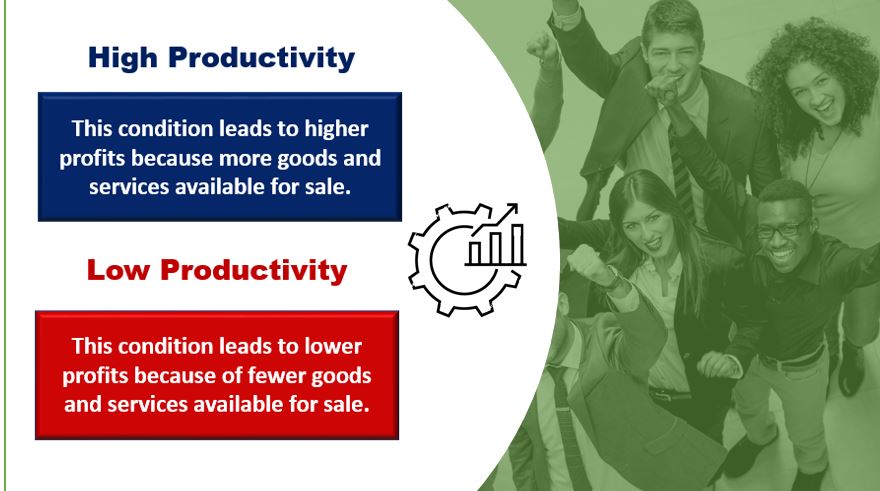 Productivity is a critical metric that significantly impacts workplace profitability and represents the relationship between the number of outputs and inputs needed to produce a product.
Productivity is a critical metric that significantly impacts workplace profitability and represents the relationship between the number of outputs and inputs needed to produce a product.
Nowadays, profitability challenges and intensely competitive markets require all employees to be fully engaged and think and work with a similar productivity mindset. A corporate culture committed to a proactive employee engagement philosophy aggressively supports employees’ wellness, work-life balance, career path and continually motivates and empowers employees’ commitment to a profitable business model.
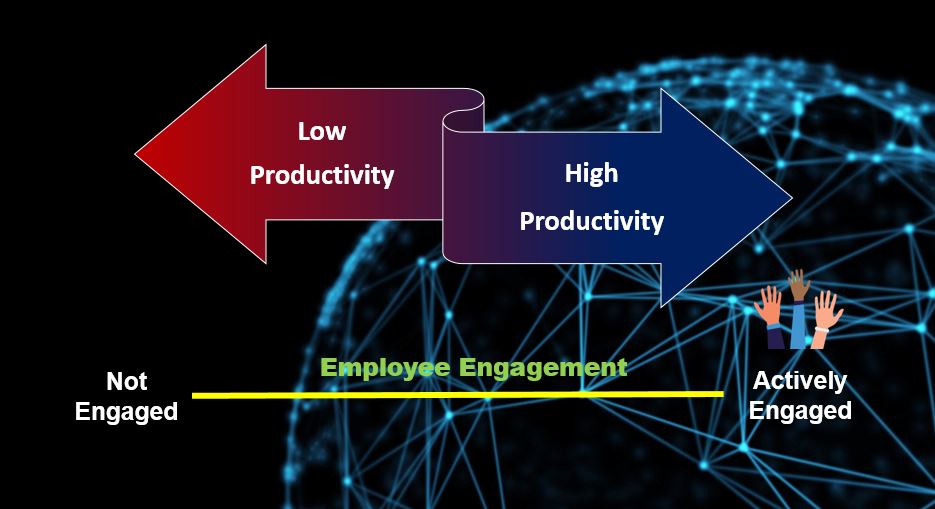
Engaged Employees are fully absorbed by and enthusiastic about their work and continually takes affirmative action to further the organization’s reputation, values, and success.
Disengaged Employees are doing the least possible work, predisposed to actively harming the company’s brand, and more or less a drain on overall production.
Most executives already understand that employee engagement directly affects an organization’s financial health and profitability.
According to Gallup’s State of the Global Workplace Study:
Only 15 % of employees are engaged in the workplace. This condition means that 85% of the workforce is viewing their workplace negatively or only doing the bare minimum to make it through the day, with little to no emotional attachment.”
Engagement and productivity are by-products of positive workplace social cohesion, fueled and supported by one’s immediate supervisor with trust, constant communication and feedback, information sharing, and straightforward collaboration. Employees need to be valued and respected and know that their work is meaningful and their ideas insightful and useful.
Although the notions of employee engagement and job satisfaction are somewhat correlated, they are not the same. Job satisfaction has more to do with whether the employee is personally satisfied than whether they are actively involved in advancing organizational goals.
Lack of an acceptable productivity-focused culture more often than not results in complications with employee performance, unwarranted turnover, and low-quality work put and effort. Company culture does not need to progress without proper direction as ‘best in class’ companies eagerly provide the necessary resources in ensuring a positive environment of high productivity throughout the enterprise.
The existence of workplace impediments and barriers hinders a company’s achievement of its productivity goals and directly influences corporate support for employee engagement. High-productive business management and employees generally are trained to recognize and avoid or quickly mitigate the effects of the problematic situations shown below.
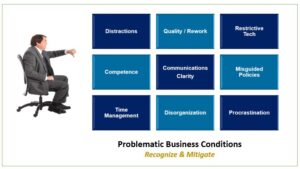
“The simple act of paying positive attention to people has a great deal to do with productivity.”
Tom Peters
Advances in productivity, that is, the ability to produce more with the same or less input, are significant sources of increased potential national income. The U.S. economy has created more goods and services over time, not by requiring a proportional increase in labor time but by making production more efficient.
Productivity and Efficiency: The Differences
There is a common misuse of the ‘productivity’ and ‘efficiency’ terms and a widespread belief they are synonyms and similar in meaning. But what is the difference between them? The two have very distinct pursuits and often compete strategically within the business.
The below graphic outlines the differences between productivity and efficiency.
“Stressing output is the key to improving to productivity, while looking to increase activity can result in just the opposite.”
Andrew Grove
The Productivity Culture
There is a recognition of the close relationship between organizational culture and productivity. An influential corporate culture entails consistent and observable patterns of positive employee comportment in the workplace. Similarly, culture is viewed as a social management rheostat to continually encourage and strengthen productive behaviors and discipline and change imprudent conduct. This view establishes repeated employee behavior as good or bad habits and the core of the existing culture that shape collective employee behaviors.
“86% of entrepreneurs believe company culture helps their productivity.”
The Alternative Board
Executives should be willing to change or refresh their traditional culture backbone to fully embrace and exploit productivity as a catalyst for long-term growth and profitability improvement. Nowadays, a business that does not view productivity with a strategic culture lens will soon stagger under its weight and fade away as a viable business.
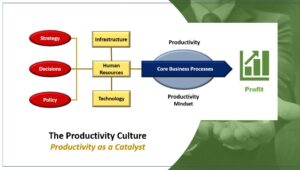
Personal productivity is the amalgamation of an individual’s intelligent planning and focused on their endeavors. While highly-effective organizations share characteristics, no widely-recognized recipe or algorithm empowers employees to view and action productivity in a standard measure. The reality is that most enterprises have limitations and must make trade-offs to implement a successful strategy to improve employee and team productivity continually.
Generally, modest changes to operating methods and processes will increase productivity. However, the most significant gains typically result from digital transformation and adopting new technologies, which may require capital expenditures for the purchase of equipment, computers, or software.
“We have no patent on anything we do and anything we do can be copied by anyone else. But you can’t copy the heart and the soul and the conscience of the company.”
Howard Schultz, Starbucks
Productivity Measures and Values
Enhanced production lowers the cost per unit of a product, resulting in lower prices for better quality and enhanced market competitiveness.
Productivity management is a priority focus of well-managed companies as they primarily deploy formal activities for continuously monitoring and improving productivity, such as production assurance and quality programs. Whether they have a structured productivity activity or not, organizations should be regularly evaluating technologies, tools, methods, and techniques to improve quality, reduce downtime and inputs of labor, materials, energy, and purchased services.
Successful productivity programs value include:
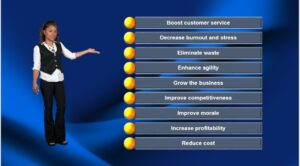 Productivity is an objective concept and can be measured. Organizational productivity measures encompass:
Productivity is an objective concept and can be measured. Organizational productivity measures encompass:
- Labor productivity, based on the gross output.
- Labor productivity, based on value-added.
- Capital-labor MFP (multifactor productivity) based on value-added
- Capital productivity, based on value-added.
Organizational productivity growth constrained by the Production-Possibility Frontier (PPF) can be illustrating in a curve showing the maximum possible output combinations of two goods or services an economy can achieve when the business entity thoroughly and efficiently employ all resources.
Companies must be cautious not to focus exclusively on productivity as the key driver for market success. While productivity is critical, it does not directly address the securing of new business. Business executives should also focus their limited resources and energies on revenue strategies for maximizing both short- and long-term sales potential.
Core Business Processes & Productivity
A business process is a collection of associated, structured activities or tasks engaged by people or equipment. This specific sequence produces a service or product for a distinct customer or set of customers. Business processes occur at all organizational levels and convert their inputs into outputs to support organizational productivity goals. Every organization’s processes vary on a scale from effective to ineffective and efficient to inefficient.
The strong oversight of business processes has a significant impact on improving the productivity of the overall business. Continually eliminating waste and discrepancies ensures that the operation can operate with suitable process velocity and throughput levels to meet productivity measures.
A business process or a sub-process is described based on the following characteristics:
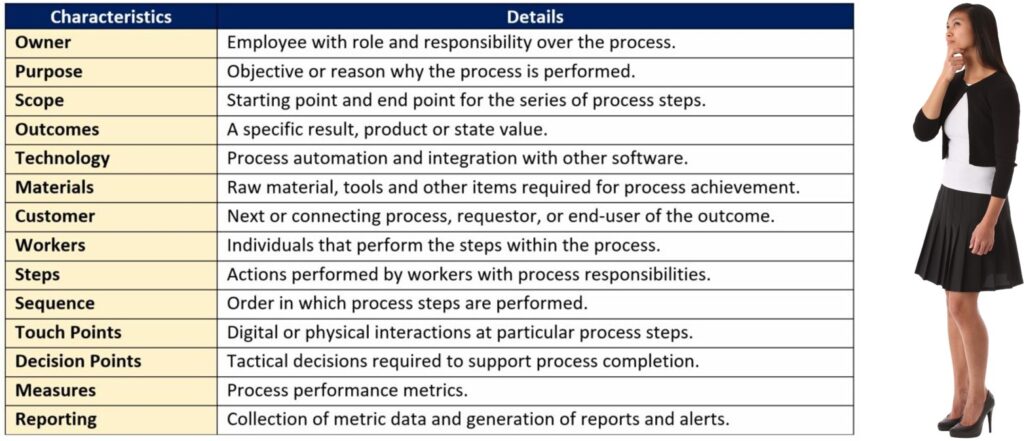
Organizations experiencing process ineffectiveness and inefficiency typically exhibit problematic workplace conditions, including:
- Absence of empowered employees to take necessary tactical decisions in real-time.
- Inadequate/outmoded business intelligence structure supporting process management.
- Lack of routine/repetitive task automation.
- Misalignment among business processes, enterprise goals, strategies, policies, and plans.
- No proactive process control and improvement program.
- Substandard onboarding and training programs.
- Time-consuming and error-prone tasks, with unnecessary process stops and redundant tasks, touchpoints, and decisions.
Every person has an individualized work effort output threshold, no matter how many ingenious methods and tools they use to improve their productivity. The management team must identify and quantify employee production limits and potential risks within their workplace strategic and tactical planning and staffing of the core business processes.
Straightforward streamlining changes to processing can boost productivity quickly and with modest disruption to business activities. Process improvement approaches and tools can result in substantial direct savings to a company’s business processes. However, the most significant improvements are adopting new technology concepts and practices and introducing new equipment, computers, and software.
There are two widely recognized techniques used to analyze business processes to identify opportunities to improve overall organizational productivity, as outlined below.
Process Mapping
Process Mapping creates a visual representation of the roles, procedures, and logical relationships between the steps and touch and decision points of a business process. The mapping technique identifies precisely what a business does, who is responsible, and the standard of measurement. A flowchart / data-flow diagram graphing tool or process mapping technique software can more productively automate this activity.
Business Process Modeling (BPM)
Business Process Modeling enables system-assisted creation of a current process workflow using a BPM software tool. The modeling gathers critical process-supporting data, using the Five Ws and One H questioning technique for testing and simulation. The modeling deliverable is a visual illustration of the current (“As-is”) process baseline and a redesigned process (“To-be”) with the incorporation of identified improvements.
The use of either technique enables identifying process discrepancies and creating improvements to improve and support business processes that exhibit the following value-add characteristics.

Productivity and Emerging Technologies
Technological innovation and enterprise knowledge are the main drivers of organizational-level productivity growth. Generally, the most substantial increases in output are achievable at a given level of input from more effective use of the current technologies. Additionally, as organizations develop and apply new technology tools and supporting innovative approaches, they can expand output and improve productivity by more than any additional inputs required with business growth.
“The exponential computing speedup offered by quantum computers will enable machine learning algorithms to rapidly identify patterns in healthcare data collected from millions of participating patients.”
Healthcare IT News
Anecdotal tales and market research support the considerable success that emerging technologies are having on organizational improvement. A selection of these technologies is outlined below with their impact on eliminating process waste and inefficiencies.
Artificial Intelligence (AI) / Machine Learning (ML)
AI and machine learning tools transform the workplaces by precise guiding, organizing, and automating work with significant productivity improvement.
Artificial Intelligence (AI) is the capability of machines to perform tasks typically associated with human activity and intelligence: reasoning, learning, natural language processing, and perception. AI provides devices the ability to mimic intelligent human behavior.
Machine Learning (ML) is a subset of AI, consisting of an array of algorithms to create specific AI-supported capabilities. The algorithms have the inherent ability to learn from data, self-modify with exposure to select data and use statistical analysis to predict an output while updating outputs as select data becomes available.
Integrating AI into legacy information and communications systems will quickly deliver high cost, time, and process-related savings. AI improves the bottom line through intelligent automation, labor and capital augmentation, and innovation diffusion. For example, by analyzing problematic situations in real-time, AI can provide early warning of potential problems and propose alternative solutions.
Business problem categories solved using AI technologies include the below areas of productivity and profitability concern.
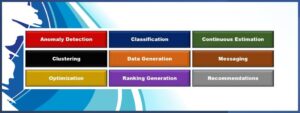
With the acceptance of AI across large industry sectors, the varieties of use cases with the most significant value potential differ by individual area. These differences mainly result from the relative value of unique drivers of significance within each industry. Also, availability and ease of accessibility of required data and the applicability of necessary algorithmic solutions influence factors.
While AI can improve productivity by replacing employees for routine tasks, it is in machine intelligence to supplement human decision-making that the real growth in business productivity will happen. Recognizing the specific roles machine learning can play is the key to maximizing both artificial and human intelligence for the smart organization.
Accenture reports:
“By 2035, Artificial Intelligence (AI) has the capability to boost productivity by 40 % or more”
Internet of Things (IoT)
The Internet of Things ( IoT) is a structure of related mechanical equipment and digital devices, objects, people, and animals provided with unique identifiers (UIDs) and the ability to transmit data over a network without human-to-human or human-to-computer communication. The connectivity expands their capabilities and generates valued data, which helps businesses to understand consumer behavior better.
A large selection of businesses, including logistics, marketing, healthcare, and manufacturing, are using IoT technologies today, and research projects that the number this will only increase as large and small companies increasingly understand the value. With the capabilities of powerful 5G wireless networks and smaller, more robust processors, it’s now feasible to convert dumb equipment to digital data devices integrated with the enterprise systems and with customers and supply chain partners.
IoT technologies support the workplace’s continual digital transformation, creative enrichments of the smart workplace, and overall organizational productivity. Usage data will provide input for predictive analytics, used to reduce failures and advance product design. By embedding them into everyday processes, IoT can modernize and streamline routine tasks, fine-tune operations, and decrease total costs.
IDC’s 7th Annual Global IoT Decision Maker Survey
“85% of survey respondents have a budget allocated towards IoT projects. Despite the belief that business decision makers hold the majority of budget, IT continues to control a lot of budget, especially since the ongoing costs to support IoT projects is not inconsequential.”
Productivity AI-Embedded Chatbots
A bot is a software app that automates or carries-out tasks for other system programs or users. Bots are deployed as add-ons to software tools, providing additional capabilities, structure, or automation on top of the product’s baseline features. Characteristically, bots perform simple and structurally repetitive tasks more quickly than with the human touch.
The use of bots on the Internet is not a new occurrence as search engines like Google have been using bots, often known as web crawlers, to search, analyze, and index content on the web, since the early 2000s.
Chatbots are among the most recognized AI technology applications that mimic human conversations via audio or text, used to communicate information through messaging applications, websites, mobile apps, or the telephone. They simulate human communication with a natural language that enables real-time responses to users based on reinforced learning.
For example, chatbots communicate through text as in Linkedin bots or via audio talking to Amazon Echo. Chatbot conversations are powered by ML Algorithms, which break down messages into understandable natural languages using NLP Techniques and responds to queries similar to the human experience.
Productivity bots are a flavor of chatbots deployed as add-ons to software tools, providing additional capabilities, structure, or automation on top of the product’s baseline features. These bots are reporting significant productivity gains by all paradigm-changing adopters of this value-add AI-embedded technology.
In a business context, personalization uses a company’s customer, product, and service information to leverage the relevancy of the underlying insights as crucial data points. This data can be necessary for demographic information or more specific niche product interest, buying intent, and customer behavioral patterns. Chatbots enable successful personalization by tapping into and leveraging the enormous amount of company data located throughout the organization’s business and support units.
You can find chatbots use case success scenarios across all industries and business functions such as customer service, sales, marketing, or internal process automation. Chatbots make it possible for SMB companies to provide a level of personalized service that once only huge, multinational corporations were able to offer.
For example, Salesforce reports that ” 64% of agents with productivity chatbots can spend most of their time solving complex problems, versus 50% of agents without AI chatbots.
Well-recognized productivity bots used throughout the workplace support the following business solutions.
- Crawl bots that search the web to create an engine index (e.g., price tracking on different shopping websites).
- Transactional bots that interact with users to carry out transactions by transferring data between different platforms.
- Chatbots converse with people (e.g., Siri and Amazon Echo).
Examples of business functions that are fundamentally changing their work scope and approach, internally and externally, with the use of chatbots include:
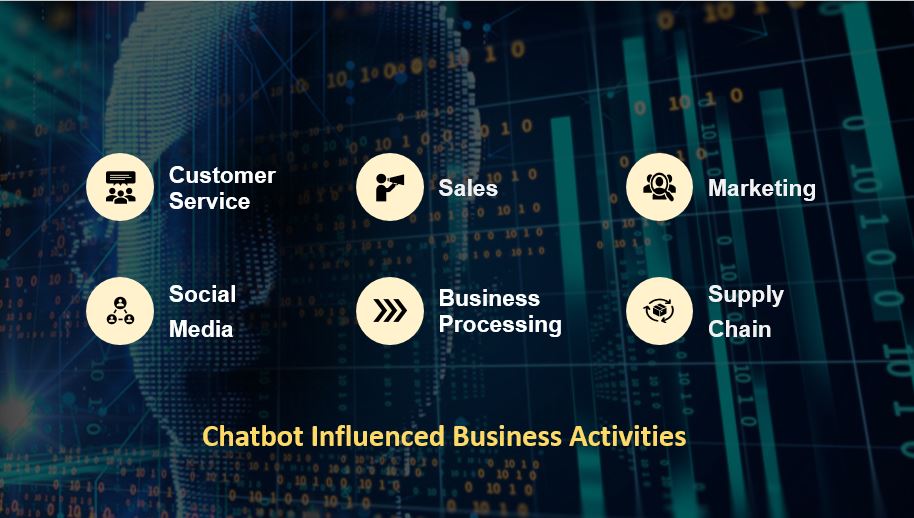
“53% of service organizations expect to use chatbots within 18 months — a 136% growth rate that foreshadows a big role for the technology in the near future.”
Salesforce
The Way Forward
At Knowledge Compass, we bring together nearly four decades of thought leadership in business and technology strategy, the latest tools and best practices, and a seasoned consultant team with the competencies and talent to help our clients improve productivity and profitability.
Knowledge Compass explores and develops valuable new insights from business, technology, and science by embracing the powerful technology of ideas and brainstorming. Our consultants engage customers in challenging discussion and experimentation to expand business science boundaries and practice and translate creative ideas into practical solutions from within and beyond business.
Working with Knowledge Compass means a collaborative approach to understanding your current business model, strategies, and critical business requirements and goals.
We enable organizations to transform and deliver improved value by ensuring employees adapt and make the most effective use of crisis management and change practices in culture, strategy, infrastructure, processing, and digital transformation. Our consultants have a deep understanding of the social and business factors that support a people-based culture aligned with the appropriate corporate strategy and goals.
Knowledge Compass provides consulting services using time-tested best practice frameworks, analysis tools, and interactions from their professional Consultant Toolbox.
